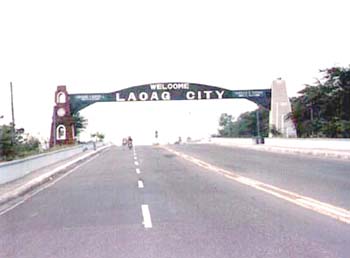

| LAOAG CITY - "Sparkling Gems of Ilocandia" |

The name Laoag is held traditionally to have derived from the word, "Lawag", an Ilocano term which means "light", "bright" or "clear". Buzeta, and Augustinian missionary in his "Diccionarios Gografico Estatistico Historico de las Islas Filipinas," states that Laoag has a clear atmosphere which presents a beautiful sky and that there is no doubt that his is the reason why the place was given the name "Laoag." At the arrival of the Spaniards in the Philippine Islands, they found out the native were divided into community groups each having its own independent government. That there were centers of population as was observed by the Captain Juan de Salcedo, Ilocos was extraordinary in size. In Laoag alone, the population reached as high as 6,000. This was the greatest number of inhabitants in a "barangay" or "puroc" in the whole country at the advent of the Spaniards. The houses of the built and compactly arranged around a hill known as Ermita Hill, located at the southeastern section of what Laoag now at the very brim of the northern bank of the Padsan River. The natives must have chosen this spot for the location of their community not only of its proximity to the river which is indispensable to them as the source of their protein, that is, fish, shellfish, and water for drinking and washing. Buzeta, commented on the practice of the Ilocanos in constructing their houses very close to one another that no space was left for their orchards contrary to the common practice of the natives in other places of the island who constructed their houses isolated in the fields adjacent to their fartms. The late Don Luis Montilla, who for several years, was Director of the National Library, said that he found questionnable documents in the National Archives which mention 1580 as the real date of the organization of Laoag as a parish under the patronage of St. William, the Hermit, whose feast is celebrated on the 10th of February every year. Before the end of the 16th century, the missionaries, in their desire to improve the living conditions of the natives, resettled the big center of the community of Laoag from Ermita Hill to its present location. This center is the present plaza of the city of Laoag. Following the gridiron pattern of Greco-Roman origin in laying out towns, Laoag City was resettled by the Spanish missionaries by first laying out the central rectangle where the location of the plaza, church, convent, tower, tribunal, and other important edifices were indicated. These were followed by the laying out of rectangular street blocks. The laying out of the poblacion done, the indigenous population were prevailed upon to construct their houses in proper places within the reach of the church bells. The poblacion was subsequently divided into different barrios, each named after a patron saint assigned to them. Though Laoag was converted into a city in 1965 through a plebicite, leaving its municipal status, it remained the capital of Ilocos Norte. The first city major was Hon. Eulalio F. Siazon. The inhabitants of Ilocos at the arrival of Salcedo were a sturdy and industrious race predominantly Malay. The first wave of Malay immigrants to the Philippines came about 200 to 300 B.C. These immigrants were the less civilized Malays - ancestors of the present Igorots, Ifugaos, Bontocs, and Tinguians of Northern Luzon. The second wave came after the Christian era, beginning about the first century A.D. and continuing through the suceeding centuries until the 13th century. These migrator waves saw the advent of the alphabet - using Malays - ancestors of the present Ilocanos, Tagalogs, Visayans, Bicols, Pampangos, and other Christian Filipinos. To these better civilized Malays belonged the Ilocanos that Salcedo found in the Ilocos in 1572.
The city of Laoag - "Sparkling Gen of Ilocandia", is located at the west central part of the province of Ilocos Norte bordering the China Sea. The name it carries now perpetuates its character as a melting pot, a place where people converge. Now, Laoag is equipped witht the necessary vigor and emerged as a giant and growth center of the north. Laoag City cradles nature at it best. Catering to all dimensions, the city, a growing tourists destination, offers a discovery of charming suprises, lush vegetation scenic beaches, highland lures and historical-painted environment. Laoag City, belonging to the North Luzon Growth Quadrangle is being developed into a tourism center of the North outside Hongkong, Taiwan, and even Japan. The city of Laog is located along the Manila North Road. Monitoring southward along the road, Vigan is 78 kilometers from Laoag, 217 kilometers from San Fernando, La Union, 363 kilometer from Tarlar and 488 kilometers from Manila. It is 274 kilometers from Bagious City. Laoag City is composed of 80 barangays - thirty comprises the poblacion while the other fifty barangays are distributed in the rural areas with a population of 87,778. It has an area of about 12,747,450 hectares. Laoag City is the commercial and trading center of the province, being capital of Ilocos Norte. The central business district is at the middle section of the poblacion's southern boundary where the supermarket, department stores, hardwares, appliance stores, banks, drugstores, bookstores, and beauty shops are located. Tourists and business can come here either by plane that will cruise 295 statue air miles or by buses coming from the north and south. The area of about 12,747,450 hectares is spread over residential, commercial, industrial, agricultural, institutional and open spaces. |






